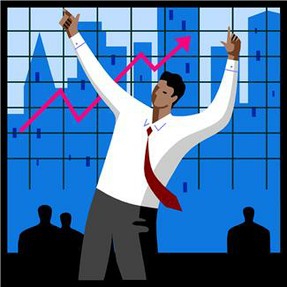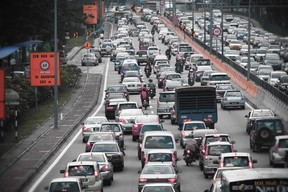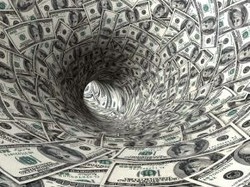Rising Gross Domestic Product (GDP) is good; declining GDP is bad. That’s the mantra of capitalism, policy making, and the electability of politicians. Nobody is going to win public office on a slogan of “Elect me and I’ll make sure the economy doesn’t grow.”
But, perpetual economic growth is not possible. We live in a closed system imposed by the boundaries of the planet; there are no inexhaustible resources available that will sustain continued growth. So, a third option is to create an economy that neither grows nor declines.
Proponents of this so-called steady-state economics recognize this and say we have to change our approach to growth. If we don’t we will be led into a trap filled with economic disasters.

Economics for a Sustainable Future
by RupertTaylor
Some economists say there is something fundamentally wrong with the way in which we measure financial health; welcome to the world of steady-state economics.
The Center for the Advancement of Steady State Economy (CASSE) offers this definition: “A steady-state economy…aims for stable or mildly fluctuating levels in population and consumption of energy and materials. Birth rates equal death rates, and production rates equal depreciation rates.”
And Drew Nelles (Globe and Mail, March 23, 2013) has a similar description: a steady-state economy is one “in which material and energy use are kept within ecological limits, the population remains stable, wealth is distributed more fairly.”
 | Beyond Growth: The Economics of Sustainable Development Named one of a hundred "visionaries who could change your life" by the Utne Reader, Herman Daly has probably been the most prominent advocate of the need for a change in economi... |
 | Prosperity without Growth: Economics for a Finite Planet Is more economic growth the solution? Will it deliver prosperity and well-being for a global population projected to reach nine billion? In this explosive book, Tim Jackson, a t... |
What’s Wrong with Gross Domestic Product?
 Measuring success by an increasing GDP alone gives a false impression of how well (or badly) an economy is doing.
Measuring success by an increasing GDP alone gives a false impression of how well (or badly) an economy is doing.
Gross Domestic Product measures everything that happens in an economy. Good stuff and bad stuff all get thrown together in a single GDP figure. So, a factory is built and people are employed turning out a useful product; that adds to the GDP figure. So does the building of a new hospital or railway.
However, an outbreak of war also adds to GDP. So too does an increase in crime because of the economic activity generated in catching criminals and housing them in prison. A disease pandemic, a massive oil spill, and a destructive hurricane also add value to GDP. Simply worshipping at the altar of increasing GDP means negative economic activity is masked and made to look like good. As the American author Edward Abbey put it: “growth for the sake of growth is the ideology of the cancer cell.”
Some economists say GDP measurements should be ditched in favour of systems that divide the bad and the good. Economist Dan O’Neill told The Globe and Mail we should “forget about growth and make the transition toward a steady-state economy that shifts our goal from increasing GDP to improving people’s lives.”
Steady-State Economy an Old Idea
In the 18th century, Adam Smith drew the blueprint for capitalism in “The Wealth of Nations.” But, he didn’t think that his notion of each person working in his or her own self-interest would lead to the never-ending growth of wealth. As CASSE points out “He predicted that in the long run, population growth would push wages down, natural resources would become increasingly scarce, and division of labour would approach the limits of its effectiveness.”
In the 19th century, John Stuart Mill wrote that after a period of expansion economies would reach a stationary state. He didn’t think this was a bad outcome. People might not be able to pile up more material goods in their basements and garages but they would likely develop a higher quality of life. Here’s how he put it: “There would be as much scope as ever for all kinds of mental culture, and moral and social progress; as much room for improving the Art of Living and much more likelihood of its being improved, when minds cease to be engrossed by the art of getting on.”
 In the 20th century, John Maynard Keynes echoed his predecessors and called the love of money detestable. He wrote that “The day is not far off when the economic problem will take the back seat where it belongs, and the arena of the heart and the head will be occupied or reoccupied, by our real problems…” He described these as human relationships and spirituality.
In the 20th century, John Maynard Keynes echoed his predecessors and called the love of money detestable. He wrote that “The day is not far off when the economic problem will take the back seat where it belongs, and the arena of the heart and the head will be occupied or reoccupied, by our real problems…” He described these as human relationships and spirituality.
More recently, other economists have written about the same view:
- Kenneth Boulding,“The Economics of the Coming Spaceship Earth,” (1966);
- Nicholas Georgescu-Roegen, “The Entropy Law and the Economic Process” (1971);
- E. F. Schumacher, “Small is Beautiful: Economics as if People Mattered” (1973);
- Herman E. Daly, “Beyond Growth: The Economics of Sustainable Development,” (1997);
- Rob Dietz and Dan O’Neill, “Enough is Enough: Building a Sustainable Economy in a World of Finite Resources” (2012).
 | Steady-State Economics: Second Edition With New Essays First published in 1977, this volume caused a sensation because of Daly's radical view that "enough is best." Today, his ideas are recognized as the key to sustainable developme... |
 | Supply Shock: Economic Growth at the Crossroads and the Steady State Solution Politicians, economists, and Wall Street would have us believe that limitless economic expansion is the Holy Grail, and that there is no conflict between growing the economy and... |
How Do We Live in a Steady-State Economy?
Our society has been programmed through marketing to want more of everything – bigger house, bigger car, bigger vacation. This, in the words of writer Robert L. Perry, puts us on a “Treadmill to Ruin.”
 Getting off the treadmill is not easy. The steady-state economists such as Dan O’Neill say it involves “bringing resource use within ecological limits, reducing inequality, reforming the financial system, and reducing unemployment.”
Getting off the treadmill is not easy. The steady-state economists such as Dan O’Neill say it involves “bringing resource use within ecological limits, reducing inequality, reforming the financial system, and reducing unemployment.”
He says governments have the instruments in their economic tool kits to achieve this. They could start by heavily taxing resource exploitation and lowering taxes on incomes. They could drastically cut defence spending and put the money saved to use in building a low-carbon economy (wind, tidal, and solar power, etc.). O’Neill also suggests guaranteeing a minimum income to all members of society as well as setting a maximum. He asks “Is there really any case for having anyone earn more than the prime minister?”
These are radical changes that leaders are not keen to even think about. But, the arithmetic is simple; we cannot continue on our current path forever.
As the Global Footprint Network says “Today humanity uses the equivalent of 1.5 planets to provide the resources we use and absorb our waste. This means it now takes the Earth one year and six months to regenerate what we use in a year.”
Sources
The Center for the Advancement of Steady State Economy.
“Is GDP the Right Way to Measure Progress? One Economist Says No.” Drew Nelles, Globe and Mail, March 23, 2013.
“Beyond Green Growth: Why We Need a World Without Economic Growth.” Christopher Doll, The Guardian, April 15, 2010.
You might also like
The Engineering Mastery of the Wright BrothersMost people recognize that the Wright brothers mastered powered flight, but f...
The Magic and Myth of British FungiMushrooms and toadstools grow all over the world, and whilst many are edible ...



 American Cop Shakedownon 09/16/2014
American Cop Shakedownon 09/16/2014
 Cliven Bundy and the Sovereign Citizenson 08/05/2014
Cliven Bundy and the Sovereign Citizenson 08/05/2014
 How Stores Manipulate Customerson 07/16/2014
How Stores Manipulate Customerson 07/16/2014
 Corruption in Russiaon 06/27/2014
Corruption in Russiaon 06/27/2014



Comments
You're absolutely right Catana. But, even the purpose of the austerity measures is to get the economy back onto the fast lane of the growth freeway.